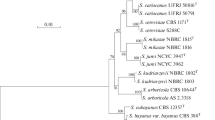Abstract
The esterase isozymes were surveyed in axenic stocks of syngens 1, 2, 4, 5, 6, and 8 of Paramecium aurelia by starch gel electrophoresis. In paramecia there appear to be four types of esterases which are clearer in axenic than in bacterized stocks. Each type differs in its substrate specificity and/or its response to the inhibitor eserine sulfate. Minor variations in type D esterases sometimes occur in different extracts of the same stock and may result from changes in the temperature of growth of the cells or growth cycle differences. Differences in the mobility of the A, B, or C (cathodal) types of esterases may occur in different syngens. They also occur for the A and B types among stocks within a syngen, but the frequency is low, except in the case of syngen 2. Since each of the types of esterases varies independently, at least four and possibly more genes appear to specify the esterases in the species complex. Some pairs of syngens vary in their electrophoretic positions for all types of esterases. Other pairs have identical zymograms. This observation suggests that some syngens may differ from each other by as many as four esterase genes, while others may not differ at all. The difference between P. aurelia and Tetrahymena pyriformis in the degree of intrasyngenic variation observed for enzymes is discussed in relation to other types of characters, the organization of the genetic material in the macronucleus, the presence of symbionts, and their breeding systems. It is suggested that enzyme variation is achieved by the action of different selective forces in these two groups of ciliated protozoa.
Similar content being viewed by others

References
Allen, S. L., and Gibson, I. (1971). Genetics of Tetrahymena. In Elliott, A. M. (ed.), Biology of Tetrahymena, Appleton, Century, Crofts, Inc., New York (in press).
Allen, S. L., and Weremiuk, S. L. (1971). Intersyngenic variations in the esterases and acid phosphatases of Tetrahymena pyriformis. Biochem. Genet. 5 119.
Allen, S. L., Byrne, B. C., and Cronkite, D. L. (1971). Intersyngenic variations in the esterases of bacterized Paramecium aurelia. Biochem. Genet. 5 135.
Beale, G. H. (1954). The Genetics of Paramecium aurelia, Cambridge University Press, London and New York, 179 pp.
Beale, G. H., Jurand, A., and Preer, J. R. (1969). The classes of endosymbiont of Paramecium aurelia. J. Cell Sci. 5 65.
Dippell, R. V. (1954). A preliminary report on the chromosomal constitution of certain variety 4 races of Paramecium aurelia. Caryologia 6 (suppl.): 1109.
Dryl, S. (1959). Antigenic transformation in Paramecium aurelia after homologous antiserum treatment during autogamy and conjugation. J. Protozool. 6 (suppl.): 25 (abst.).
Kościuszko, H. (1965). Karyologic and genetic investigations of syngen 1 of Paramecium aurelia. Folia Biol. 13 339.
Nanney, D. L. (1964). Macronuclear differentiation and subnuclear assortment in ciliates. In Locke, M. (ed.), The Role of Chromosomes in Development, Academic Press, New York, pp. 253–273.
Pringle, C. R. (1956). Antigenic variation in Paramecium aurelia, variety 9. Z. Induktive Abstammungs-Vererbungslchre 87 421.
Pringle, C. R., and Beale, G. H. (1960). Antigenic polymorphism in a wild population of Paramecium aurelia. Genet. Res. Camb. 1 62.
Rafalko, M., and Sonneborn, T. M. (1959). A new syngen (13) of Paramecium aurelia consisting of stocks from Mexico, France and Madagascar. J. Protozool. 6 (suppl.): 30 (abst.).
Raikov, I. B. (1969). The macronucleus of ciliates. In Chen, T.-T. (ed.), Research in Protozoology, Vol. 3, Pergamon Press, New York, pp. 1–128.
Rowe, E., Gibson, I., and Cavill, A. (1971). The effects of growth conditions on the esterases of Paramecium aurelia. Biochem. Genet. 5 151.
Shaw, C. R. (1969). Isozymes: Classification, frequency and significance. Intern. Rev. Cytol. 25 297.
Soldo, A. T., Godoy, G. A., and van Wagtendonk, W. J. (1966). Growth of particle-bearing and particle-free Paramecium aurelia in axenic culture. J. Protozool. 13 492.
Sonneborn, T. M. (1957), Breeding systems, reproductive methods and species problems in protozoa. In Mayr, E. (ed.), The Species Problem, Am. Assoc. Adv. Sci. Symp., Washington, D.C., pp. 155–324.
Sonneborn, T. M. (1958). Classification of syngens of the Paramecium aurelia-multimicronucleatum complex. J. Protozool. 5 (suppl.): 17 (abst.).
Sonneborn, T. M. (1966). A non-conformist genetic system in Paramecium aurelia. Am. Zoologist 6 589 (abst.).
Sonneborn, T. M., Schneller, M. V., Mueller, J. A., and Holzman, H. E. (1959). Extensions of the ranges of certain syngens of Paramecium aurelia. J. Protozool. 6 (suppl.): 31 (abst.).
Tait, A. (1970). Enzyme variation between syngens in Paramecium aurelia. Biochem. Genet. 4 461.
van Wagtendonk, W. J., and Soldo, A. T. (1965). Endosymbiotes of ciliated protozoa. In Progress in Protozoology, Excerpta Medica Foundation, Internat. Congress Series No. 91, p. 244.
van Wagtendonk, W. J., Goldman, P. H., and Smith, W. L. (1970). The axenic culture of strains of the various syngens of Paramecium aurelia. J. Protozool. 17 389.
Author information
Authors and Affiliations
Additional information
Supported by research grants from the National Institute of General Medical Sciences (GM-15879), U.S. Public Health Service, and from the British Medical Research Council.
Rights and permissions
About this article
Cite this article
Allen, S.L., Gibson, I. Intersyngenic variations in the esterases of axenic stocks of Paramecium aurelia . Biochem Genet 5, 161–181 (1971). https://doi.org/10.1007/BF00485643
Received:
Revised:
Issue Date:
DOI: https://doi.org/10.1007/BF00485643



